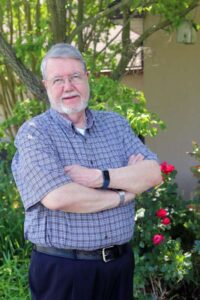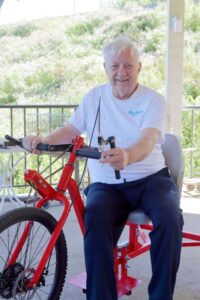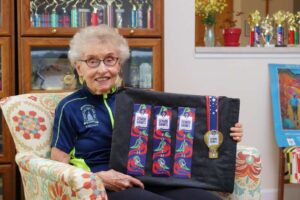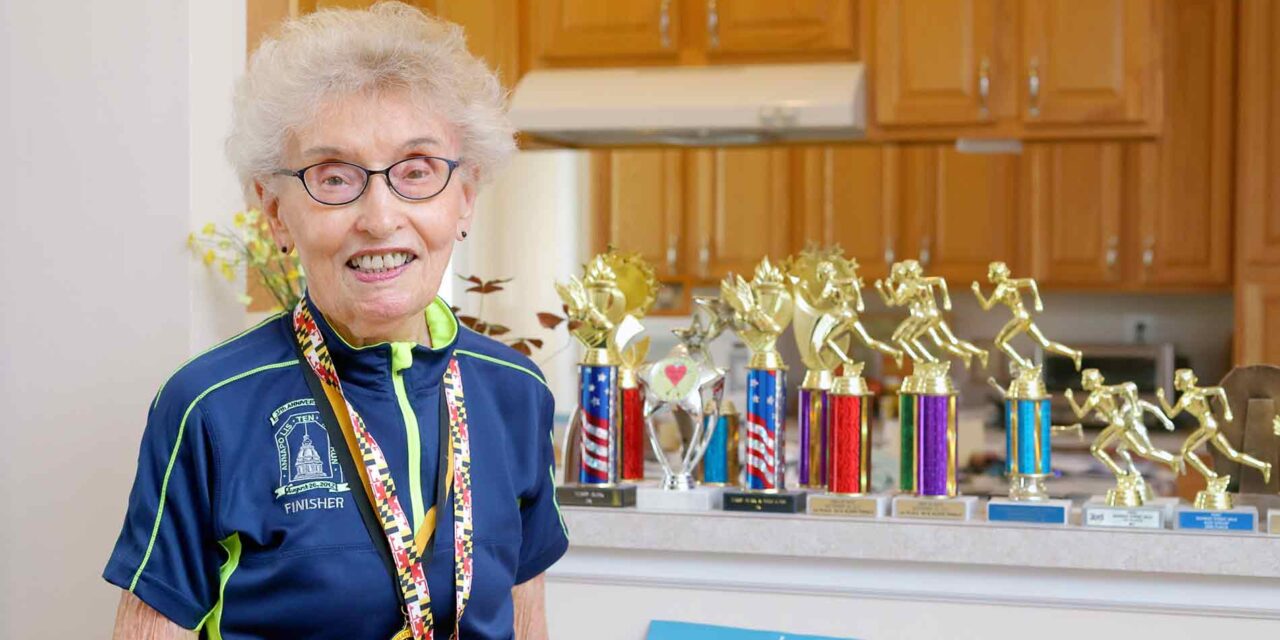by Kym Byrnes – photography by Nikola Tzenov
In spite of having surgery to clear her arteries two weeks prior, in 2019 Yvonne Aansen earned several ribbons in the National Senior Games (Olympics) in Albuquerque, New Mexico. She was 87 years old at the time.
Dave Hall works tirelessly building modified bikes, wheelchairs and other equipment for individuals who are blind or disabled. He’s overseen construction of more than 50 houses for Habitat for Humanity, and he works with college students to help them use their engineering skills to help those in need. He is 74.
After a professional career in the medical field, Dr. Alva Baker was drawn back to medicine and now works at Hospice of Washington County. He helps run the literary magazine in his independent living community, he is a lay speaker at his church and he teaches at McDaniel College. He is 77.
Today’s seniors are living a different “old age” than seniors did just 50 years ago, and the trend is expected to continue as America’s senior population continues to grow. According to the U.S. Census, the U.S. population is projected to age rapidly. By 2034, people aged 65 and older are expected to outnumber children under 18, and by 2060, nearly one in four Americans will be at least 65 years old.
Due to advances in medicine, health care and technology, people are also living longer. In 2017, the life expectancy in the U.S. was about 80 years old. By 2060, it’s expected to be about 86 years old, according to the Census.
“I remember when my grandfathers retired from working, there was nothing for them to do unless they had a hobby,” Alva Baker recalls. “Back then a lot of men devoted themselves to the same occupation for 40 or 50 years and when the age of 65 came, they were told to retire. They didn’t have anything else to do, or other interests, so they sat on the front porch in a rocking chair and within a few years died. All that has changed.”
Baker served as the medical director at Fairhaven Sykesville (now Acts Fairhaven) for almost 30 years and now lives at the property with his wife, Ellen. He said that in general there is no longer a mandatory retirement age and people today are more inclined to change careers later in life or even to launch a second career after retiring. Other seniors get involved with social organizations and volunteering.
“Most of the 60- and 70-year-old people that I know are not content to sit on the front porch in a rocking chair — they want to be active and involved. There are so many things they can do now that they couldn’t do 50 years ago,” Baker said.
Baker suggested that generally we think of “old” as 10 to 20 years older than our current age. But he said that from a regulatory standpoint, you’re “old” when you turn 65 because that is when Medicare falls into place for the vast majority. But he said that construct may have to evolve in the coming years.
“I think over the next decade or so we’ll see some restructuring of that time frame concept and acknowledge that oldness does not start at the chronological age of 65,” Baker said. “Oldness should better be thought of in terms of functional ability as one ages.”
Baker stays active at Acts Fairhaven through activities both on campus and off. He said that a year after retiring he came to the realization that a retirement spent pursuing pleasures was not as meaningful to him as the work he had done as a physician. So he returned to medicine. In addition to his work at Hospice of Washington County, his time is also filled by teaching in the gerontology program at McDaniel and his involvement with the literary magazine at Fairhaven as well as a resident-run website. He and his wife are also very active in their Sykesville-area church.
A growing population of very active seniors

Dr. Alva Baker served as the medical director for ACTS (Fairhaven) in Sykesville for almost 30 years and now resides there with his wife, Ellen.
Dan Andersen is the coordinator of the master’s degree program in gerontology and the director of the Center for the Study of Aging at McDaniel College. He said that it is unprecedented to have a quarter of the population over the age of 65, and that the U.S. is facing a major shift that will affect every part of our lives.
“We are not at all prepared, given the current state of things, to make this a positive experience for everybody,” Andersen said. “We need to adjust as a society to have people live in retirement for 30-plus years when previously it has been much less than that.”
According to Andersen, the economy needs to change in order to support aging seniors as well as to continue benefiting from a senior population that is active and engaged. The infrastructure of healthcare and how older people live needs to evolve, and young people have to be thinking about and planning for their senior years well in advance of reaching them.
“There is a misconception of older adults retiring and just fading away into some recreational bliss — there is some of that and there should be — but people can and do continue to contribute meaningfully for years, for decades, after they retire,” Andersen said. “The entire economy needs to change to continue benefiting from older adults.”
Anderson pointed out that many seniors continue to boost the economy by providing care for grandchildren, by volunteering, and by working part-time or full-time jobs. He said we’re at a point where we need to think through new stages of the life course — just like “adolescence” was created once kids were no longer working in factories, we need to reconsider the post-retirement phases of life.
Dr. Paul Reinbold, the chief medical director at Acts, said people are clearly staying more active to older ages than they did in the past. He said that activity and exercise are being sustained throughout life, even as people age. Better healthcare, including orthopedic procedures that correct age-related joint issues, are allowing continued mobility that was not possible in the not-too-distant past, he said.
Reinbold said the main illnesses impacting seniors continue to ultimately be related to cardiovascular diseases or cancer, but added that many interventions and therapies for a host of the specific illnesses in these categories have improved outcomes for those who are affected. Also, however, because people are living longer and medicine and healthcare are helping us treat physical ailments, we are seeing more seniors suffering from cognitive disease, Reinbold said.
“This has led to an increased burden of cognitive diseases, Alzheimer’s and others, as these are progressive diseases that occur with increased frequency as age increases. As the population in general ages, the number of those with dementia will increase concomitantly,” Reinbold said.
The drive to give back

Dave Hall has grown into the volunteer work, giving back to help others improve their quality of life.
At 74, Dave Hall joked that he is considered one of the youngsters at Carroll Lutheran Village, where he lives with his wife, Wanda. “I interact with so many active people here who are in their 80s and 90s, I guess 90 is the new ‘old.’”
Prior to retirement, Hall worked as an electrical engineer, primarily in the steel industry. After his children were grown but before retiring, Hall said he put his engineering skills to work by volunteering with Habitat for Humanity, and he’s been finding ways to give back ever since.
After 14 years and 52 homes built for Habitat for Humanity between Harford and Carroll Counties, back and hip issues forced him to give up construction work. But in that time he had made connections with some individuals with disabilities and said he became invested in other projects that eventually led him to an organization called Volunteers for Medical Engineering (started by John Staehlin, another resident at Carroll Lutheran Village).
Hall literally has his hands in all sorts of projects — from fixing braille writers for Carroll County Public Schools to building a special light to help a fellow senior with macular degeneration continue to play cards, to designing and building a custom cycle for a child with spina bifida to modifying bikes for children with disabilities. He serves as a secretary for the Carroll County chapter of the Federation for the Blind, and he works with college students to improve upon his custom equipment designs so that they can be produced more efficiently, cutting the three- to four-month wait time for kids who need his custom builds.
Hall said he grew into the volunteer work as he found the time to do it later in life. He emphasized that there are many seniors like him, giving back in different ways, and that he could not do the work if not for organizations like Volunteers for Medical Engineering (now known as The Image Center) that help finance his projects and help connect him to the folks he helps.
“Somewhere along the line I decided I’m very lucky,” Hall said. “My children are healthy, my grandchildren are healthy, my wife is healthy, I’m living here on a cruise-on-land at Carroll Lutheran Village. I’ve always enjoyed building things, and I have the ability to do it right now, so that is the simple reason for why I give back.”
Running towards old age

Yvonne Aasen is proud of her work to help the study of aging.
Yvonne Aasen started running when she was 46. Her husband had a heart attack and part of his therapy was to increase his walking to four miles a day. She said she walked with him for six weeks and then started running a few yards here and there. She worked her way up to running a quarter of a mile, then half a mile, then a mile. The following spring she ran her first 10K and she has been racking up the miles ever since.
The Carroll Lutheran Village resident, who turns 90 on Aug. 27, is proud to list off her running accomplishments, which include participating in countless races and runs; belonging to several running clubs; earning a slew of medals and competing in several state and national senior Olympics. In 2019, just two weeks after an angioplasty procedure, Aasen traveled to Albuquerque to compete at the National Senior Olympics — she took fifth in the 400 meters, sixth in the 800 meters, fourth in the 5,000-meter road race, and her 4×100-meter relay team took gold. She says she could have gotten the bronze in the 5,000 meters but just couldn’t muster a kick at the end of her race on that day.
Growing up in North Dakota, Aasen lived through the Great Depression and the Dust Bowl. She said she ran a lot as a child living on a farm — to fetch the mail, to chase the dogs, to get the cattle. “In my mind’s eye I can still see the boys in high school going to cross country training. There was no sport like that for girls.” Aasen admits that even if there had been a girls track program, she would have been too shy to join.
Aasen said her senior years have looked very different from what she saw when she was growing up. “I don’t think my mother or grandmother ever would have run a 5K or 10K,” she said with a laugh.
“For about seven years I was the editor of the Annapolis Striders newsletter, and my mother didn’t think I should be doing that,” Aasen said. “She thought I should be doing other things. Parents can’t necessarily expect their children to live the way they lived.”
Besides her running, Aasen said she is very proud of the work she does to contribute to the study of aging and understanding of how we age. She participates in two long-term aging research studies — the Baltimore Longitudinal Study of Aging (BLSA) and an Alzheimer’s study at Johns Hopkins University. According to the National Institute on Aging, the BLSA is America’s longest-running study of human aging and aims to answer critical questions about what happens as people get older. The study was started in 1958 and has already resulted in thousands of scientific papers. Aasen has participated for nine years and goes in annually for a series of tests.
“Participating in the studies is really important to me. It’s one of the things that keeps me active,” Aasen said. “It gives some meaning to my running career, beyond my own pleasure. They use this research to make recommendations and to understand what exercise can do in the aging process.”
While she lost her husband to pancreatic cancer in 2005, Aasen stays busy with five kids and 10 grandchildren, who live as far away as Montana and as close as Reisterstown. She said she ran more than 40 races in one year during her prime — her prime being her 70s and 80s. And even at 89 she is not hanging up her running shoes.
“Peripheral artery disease has really slowed me down. I’m on a heart-healthy diet to help keep my arteries clear and I’m working hard to get back into running,” Aasen said. “I walk a mile, sometimes two or more, every day, but I can only run a few yards. But I’m still working at it.”
Dan Anderson at McDaniel said that there is much work to be done in the coming years — by individuals who prepare themselves health wise and financially to age gracefully, and as a society as we prepare for a population boom of seniors. But in spite of that, he said that he is optimistic about the future.
“The surge of older adults we’re seeing also happens to be a group of people that have changed the fabric of society already, they are the ones who are changing the norms around aging, so I’m optimistic,” Andersen said. “The baby boomer generation has proved time and again that they can and will re-envision reality.”

